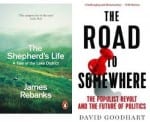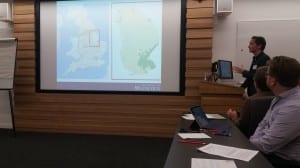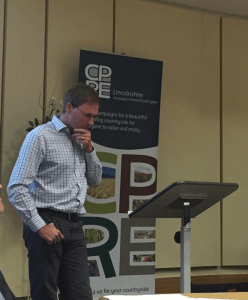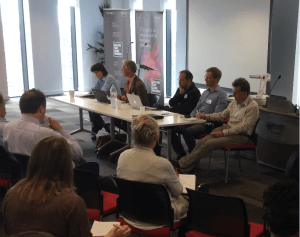 I have been reading 2 books that together tell a powerful story about changing communities, with particular reference to rural places. The Shepherd’s Life (James Rebanks) is an autobiography of a Lake District shepherd who continues a long family tradition despite prevailing social trends that see more and more people leaving the land, with sons and daughters encouraged to seek higher education, fame and fortune away from their home communities.
I have been reading 2 books that together tell a powerful story about changing communities, with particular reference to rural places. The Shepherd’s Life (James Rebanks) is an autobiography of a Lake District shepherd who continues a long family tradition despite prevailing social trends that see more and more people leaving the land, with sons and daughters encouraged to seek higher education, fame and fortune away from their home communities.
Meanwhile, The Road to Somewhere (David Goodhart) seeks to relate the politics of Brexit to underlying social change. Two categories of “somewhere” and “anywhere” people are described. The former are more rooted with their identities based on group belonging and particular places. The latter tend to do well at school, move to a residential university and on to a professional career and have “portable ‘achieved’ identities”. They can view the world from anywhere and they can achieve anywhere. Describing the growth, and particularly the growing influence, of “Anywheres” in our society, the upshot is that “somewheres” are viewed as “left behind” and outdated. With reference to older white working class men in particular, their plight is linked with the declining respect for apprenticeships and working class or skilled manual employment.
This notion of being outdated and left behind chimes with a number of stereotypes of rural areas. Indeed, the older age and predominantly white British composition of rural communities also suggests a dominance of “somewheres” in rural communities. James Rebanks would be one of those “left behind” had he believed his school teachers who saw a life as a shepherd as lacking ambition and certainly not a “career”. Instead, this affront to his family’s way of life (and from a teacher at a local school attended by generations of farmers and shepherds) was an indication that he would have to fight to continue the family farming tradition, not only against the annual challenges of weather and nature but also against a host of “outsiders” who felt that they had a stake in the Lake District – and therefore could affect his way of life. Schooling was acclaimed as a “way out” but James didn’t want a “way out”. He said “I never once wished I’d gone to University. The few people that I knew who had been didn’t seem to have come back any wiser. They seemed to have returned home full of nonsense. And they never really fitted in again.” These people had become anywhere people. Despite passing none of his GCSEs, James did study for a degree at Oxford, combining studies with regular returns home to support the family farm. He now combines farming with writing, blogging and working as a consultant for UNESCO, demonstrating the need for even the most rooted people to look outwardly in today’s world.
Does this make James an “anywhere”? No. The Shepherd’s Life is full of references to family, to neighbours, to nature, to weather and above all to “place”. It is the very connection to the Lake District, the farm, the fells and the local community combined with a keen-eyed self-reflexivity that allows him to be more than just a shepherd. His school teacher would, I am sure, be proud and feel vindicated that education was the route to a more rounded and fulfilling career but I wonder what James himself feels about this? Is it an admission that shepherding alone can no longer sustain a family livelihood or is it a genuine passion to spread a positive message about farming, shepherding and traditional country values? I sincerely hope it is the latter, but the challenges of hill farming are associated low incomes are well documented.
The reason for writing about these two books together is that James provides a snapshot of “somewhere-ness”, but written in a style that “anywheres” can understand. It is not nostalgic for a better past, it is not racist, it is not introverted and it is eloquently presented, honest and open. I suspect many “anywheres” would actually be envious of the rootedness of James and his family – this is the one thing that “anywheres” are so often looking for, especially as they settle down into family life. The continuing trend of counterurbanisation among the 35+ age groups is testament to people’s need to find a place that they can call home. The problem comes when that rural home is not quite what it seems from the postcard, TV programme or weekend break. Rural England is a complex mix of somewhere and “anywheres”. The “somewheres” will feel threatened by the globalisation of agriculture, the loss of local services to the Internet, the growth in longer distance commuting and the overriding sense that they are powerless to slow down the change that is happening to ‘their’ place. Meanwhile, the “anywheres” are looking for a sense of community that they themselves are changing.
To my mind, “anywheres” are the result of the consumer society – they epitomise consumerism to the extent that their choice of where to live is a consumer choice. Just as we might buy a piece of furniture for a combination of aesthetics, practicality and image (to show off to our dinner party guests), so “anywhere” people do the same with their houses. Once in that house, the choice of whether to use the village pub or shop is also part of a much wider range of retail and leisure options open to the cosmopolitan, IT-savvy and highly mobile people. For “anywheres”, this is not a great problem. If the village pub closes, it is sad because their village is suddenly a little less desirable and the cachet of inviting friends to the village gastropub is lost. But there are plenty more gastropubs and restaurants in the local area and after a short period of lament, the world moves on. For the “somewheres” in that community though, the home of several sports teams, the meeting point for several societies and the social connections of many people, especially older people living alone, are all lost.
David Goodhart explains that the high proportion of “somewheres” that voted for Brexit can be explained by their sense of marginalisation from mainstream politics and the decline of their relative economic fortunes. “Anywheres” still struggle to grasp this on their belief that we will be worse off (based on a capitalist economic model where growth is the primary objective) outside of the EU. That a majority of farmers voted to leave the EU when the Common Agriculture Policy provides such a large share of their income must be anathema to “anywheres”. But then we should ask why farmers are so reliant of subsidies. Returning to James Rebanks, his experience of the foot and mouth outbreak where generations of selective breeding could be wiped out by the decisions of Westminster bureaucrats is just one example where farmers’ local and professional knowledge can be so easily swept aside.
Farmers are independent people, proud to make a good living from their local resources, but now they are dependent on a range of external agencies and, perhaps understandably, envisage a better future if only they could take back some control. Will this happen outside of the EU? – probably not. Will farmers’ be as competitive on world markets? Will the UK government provide subsidies to the same extent as the EU did – again, perhaps not. Most likely, there will be a few James Rebanks who can marry traditional farming with other activities to sustain a good living for their families, there will be a few hobby farmers and “land managers” receiving income for maintaining the highly prized British countryside and there will be an even greater dominance of agri-business, mopping up the land that is offers only marginal returns to the smaller farmers.
The result: more sons and daughters of farmers using the income from the sale of the farm to pay their university fees; more rural places colonised by counterurbanisers whose values will dominate village society from the School Board of Governors and Parish Council to the social activities which might become more U3A rather than darts teams; and a more outwardly networked workforce with fewer rural businesses operating as integral parts of their rural communities. In essence, more “anywhere” people, and further marginalisation of those who do not have a university degree and are not part of the digital society or the knowledge economy.




